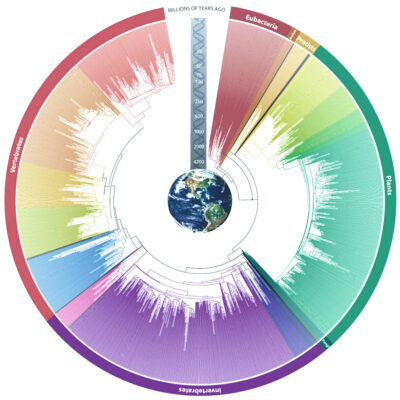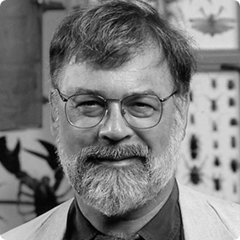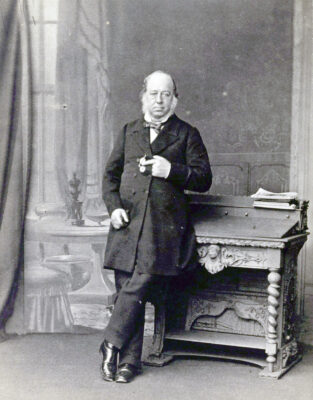Time is the fourth principle driving Charles Darwin’s theory of evolution, “by means of natural selection.” As with the other four principles, time—specifically, the timeframes of Earth’s history—challenges Darwin’s theory of “slight, successive” changes.
The theory of natural selection is contingent on extended periods of time. In The Origin of Species, Darwin wrote –
“I do believe that natural selection will generally act very slowly, only at long intervals of time.”
Niles Eldredge

Niles Eldredge (pictured right) at the American Museum of Natural History developed the V.I.S.T.A. acronym to codify Darwin’s theory. The “T” represents time, which is expressed in various ways, including intervals of time, timelines, timescales, timetables, and timeframes.
Scientifically validating Darwin’s “slight successive” theory hinges on finding evidence of “long intervals of time” in Earth’s biosphere history. Geology and biology are the foundational pillars of Earth’s biosphere.
Without time, the universe would not exist. The fields of geology and biology hold the keys to understanding Earth’s history of time.
This article examines the history and current understandings of popular evolution timeframes. The term timeframe is used interchangeably with modern concepts of timelines and timescales.
Enjoy the fascinating journey and its many turns.
Natural Selection Time Constraint
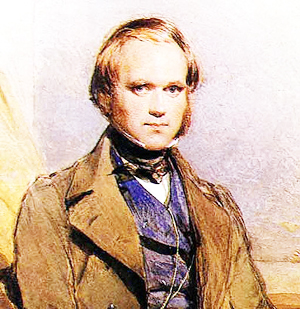 Evolution is understood as a gradual process shaping Earth’s enormous and diverse biosphere, unfolding over long periods of time. Darwin continually noted –
Evolution is understood as a gradual process shaping Earth’s enormous and diverse biosphere, unfolding over long periods of time. Darwin continually noted –
“Natural selection generally acts with extreme slowness.”
While long time intervals are a theoretical necessity, finding evidence of these remained beyond Darwin’s reach to quantify. Darwin explains why –
“Unfortunately, we have no means of determining, according to the standard of years, how long a period it takes to modify a species; but to the subject of time we must return.”
Physical evidence for long periods of time is essential, a theoretical necessity. Ironically, Darwin reasoned why the geological evidence seemed to be missing, in part: “long intervals of time” –
“The crust of the Earth is a vast museum; but the natural collections have been imperfectly made, and only at long intervals of time.”
On the principle of time, circular reasoning plays a role in understanding Earth’s history. However, is the dilemma with the evidence or with Darwin’s theory?
Evolutionary theory is entangled with dating methods. Over the centuries, the development of modern technologies and scientific methods has now provided a fascinating answer to Darwin’s dilemma.
Nineteenth-Century Geology
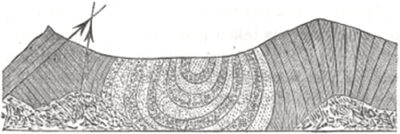 During his five-year voyage on the HMS Beagle, Darwin recorded detailed descriptions of rock formations, fossils, and wildlife. These include drawings of the uplifted landmasses of South America. However, he published the drawing, pictured left, only later in his Geological Observations publication – in 1876.
During his five-year voyage on the HMS Beagle, Darwin recorded detailed descriptions of rock formations, fossils, and wildlife. These include drawings of the uplifted landmasses of South America. However, he published the drawing, pictured left, only later in his Geological Observations publication – in 1876.
Once aboard, Darwin’s observations were increasingly influenced by the emerging new concept of geology known as uniformitarianism. The concept posits that geological forces throughout Earth’s history have remained relatively constant, resulting in only gradual changes.
Uniformitarianism (pictured left) eliminates concepts of rapid, short-term, and massive events, such as the biblical flood in Genesis. Charles Lyell (1797-1875), Professor of Geology at King’s College London, encapsulated and further popularized the theory in the phrase (pictured right) –
“The present is key to the past.”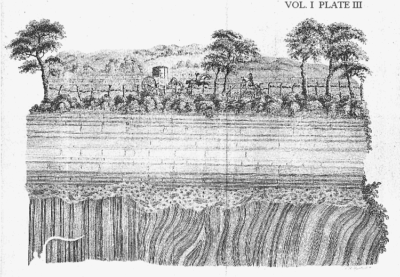
By logical reasoning, imperceivable gradual changes signifies Earth’s crust must have developed over long periods of time.
Charles Lyell
 Just before departing England in 1831, Captain Robert FitzRoy gave Darwin Lyell’s first volume entitled The Principles of Geology. The two sequel volumes, published in 1832 and 1833, were shipped to Darwin by his mentor John Henslow (pictured left).
Just before departing England in 1831, Captain Robert FitzRoy gave Darwin Lyell’s first volume entitled The Principles of Geology. The two sequel volumes, published in 1832 and 1833, were shipped to Darwin by his mentor John Henslow (pictured left).
In the second volume, released in 1832, Lyell envisioned Earth’s vast biosphere slowly emerging in the context of uniformitarianism, suggesting –
“Each species may have had its origin in a single pair, or individual, where an individual was sufficient, and species may have been created in succession.”
Lyell’s vision of gradual geological changes over vast periods of time influenced Darwin’s emerging concepts of biological evolution. Uniformitarianism logically aligned with Darwin’s emerging “long intervals of time” concept. In 1834, after returning from a river expedition, Darwin declared himself a “Lyellian.”
John Gould
During the same year, Darwin sent his fifth and last shipment of notes, drawings, and artifacts back to England for evaluation. Many were sent to the Zoological Society of London and examined by John Gould (pictured right), the first curator of the museum.
After returning to England in 1836, Darwin and Lyell began corresponding frequently. By 1863, Lyell, referring to Darwin’s work in his new book, The Antiquity of Man, wrote –
“Hitherto, no rival hypothesis has been proposed as a substitute for the doctrine of transmutation [evolution].”
Lyell exchanged letters with Darwin for decades. However, prior to 1855, none of these letters were about natural selection. Then, after reading a draft manuscript just one month prior to the publication of The Origin of Species, Lyell wrote to Darwin –
“It is a splendid case of close reasoning & long sustained argument throughout so many pages, the condensation immense, too great perhaps for the uninitiated but an effective & important preliminary statement which will admit even before your detailed proofs appear of some occasional useful exemplifications.”
For Lyell, while he respected Darwin’s “preliminary argument,” he concluded the logic was missing “detailed proofs.”
Ironically, Lyell’s concept was later recognized as lacking evidence, too. Lyell had built his theory on James Hutton’s theory, not “detailed proofs.”
James Hutton
 The concept of uniformitarianism was introduced by eighteenth-century Scottish geologist James Hutton (1726-1797) – pictured left. Earth, according to Hutton, was from an infinite past and continues into an infinite future, such that there is –
The concept of uniformitarianism was introduced by eighteenth-century Scottish geologist James Hutton (1726-1797) – pictured left. Earth, according to Hutton, was from an infinite past and continues into an infinite future, such that there is –
“No vestige of a beginning, no prospect of an end.”
Hutton proposed a continuous deep-time cyclical model of Earth’s history without timeframes. He is often called the “father of modern geology.” Hutton’s seminal work, Theory of the Earth, appeared in 1795. At the time, Hutton and Lyell were the contemporary intellectual giants in geology.
However, earlier in 1759, Italian geologist Giovanni Arduino (1714-1795) introduced his geological model that ran contrary to Hutton’s uniformitarian theory.
Giovanni Arduino
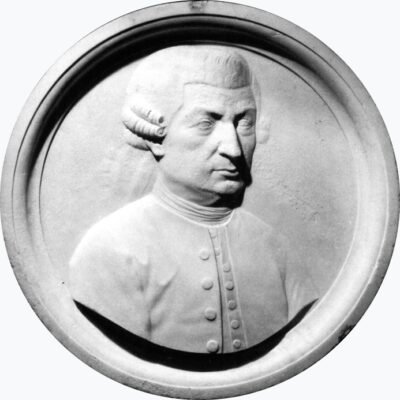 In a pair of letters sent to fellow Italian naturalist, Antonio Vallisneri Jr., Arduino interpreted his observations of the Italian Alps. Rather than Hutton’s uniform timeframe, Arduino (pictured right) envisioned Earth’s crust developing by distinct layers during episodic timeframes.
In a pair of letters sent to fellow Italian naturalist, Antonio Vallisneri Jr., Arduino interpreted his observations of the Italian Alps. Rather than Hutton’s uniform timeframe, Arduino (pictured right) envisioned Earth’s crust developing by distinct layers during episodic timeframes.
Arduino called these timeframes Primo Ordine (Primitive), Secondo Ordine (Secondary), and Terzo Ordine (Tertiary). In 1760, Arduino added his Quarto Ordine (Fourth Order), now known as the Quaternary Period.
Arduino’s timeframe concepts eventually emerged as the foundation for modern stratigraphic classification systems. As the youngest layer, the Quarto Ordine appeared to be the result of a single cataclysmic flooding phenomenon – an unacceptable concept for Darwin.
Abrupt environmental shifts are incompatible with slow adaptation and evolutionary continuity. In yet another irony, while Lyell’s uniformitarian concept aligned with what Darwin needed, Lyell was a longtime skeptic of natural selection.
Lyell, Natural Selection Skeptic
Darwin and Lyell were colleagues, corresponding often. At one point, Darwin noted that his concepts “came half out of Lyell’s brains.” However, based on geological evidence, Lyell remained skeptical of Darwin’s theory. In The Principles of Geology, Lyell wrote –
“There is no foundation in geological facts, for the popular theory of the successive development of the animal and vegetable world (natural selection), from the simplest to the most perfect forms.”
While uniformitarianism would solve Darwin’s time issue, he still required evidence to synchronize geology with biology – geobiological evidence. Darwin sought to resolve the apparent tension between his theory and the geological evidence.
Darwin’s Time Search
Geology
 By the nineteenth century, Earth’s crust was understood as a composite of sedimentary layers. Older layers were covered by younger ones, a concept known to follow the Law of Supposition.
By the nineteenth century, Earth’s crust was understood as a composite of sedimentary layers. Older layers were covered by younger ones, a concept known to follow the Law of Supposition.
This concept was first introduced by Nicolas Steno (1638-1686) – pictured left. Steno envisioned the Earth’s crust as a uniform accumulation of sedimentary layers. Arduino applied Steno’s concept a century later to develop his classification scheme.
In essence, Steno introduced the grammar of stratigraphy; Arduino wrote a taxonomy of geological timeframes. Eventually, Arduino’s concepts undermined Hutton’s and Lyell’s uniformitarianism concept.
However, Steno’s, Arduino’s, and Lyell’s geological concepts inferred a degree of credibility to Darwin’s requirement for long periods of time.
Despite whatever the composition of Earth’s crust, Darwin needed “detailed proofs” for “long periods of time.”
Darwin’s Time Study
 To validate his time assumptions, Darwin independently performed a geological study in the Weald area of South East England. Reporting his findings in the first edition of The Origin of Species, noting –
To validate his time assumptions, Darwin independently performed a geological study in the Weald area of South East England. Reporting his findings in the first edition of The Origin of Species, noting –
“I conclude that for a cliff 500 feet in height, a denudation of one inch per century… At this rate, on the above data, the denudation of the Weald must have required 306,662,400 years; or say three hundred million years.”
The Weald area is known for its unique geological ridge and valley formations. However, Darwin never explained how he arrived at a calculated age of 300 million years for the area.
By the third and subsequent editions, Darwin deleted any references to his Weald time study calculations. Darwin increasingly recognized the perplexing nuances of geology, which conflicted with his theory of natural selection, noting –
“I allude to the manner in which species belonging to several of the main divisions of the animal kingdom suddenly appear in the lowest known fossiliferous rocks.”
Geological Conflicts
This appearance of advanced life forms early in Earth’s stratigraphic history undermines Darwin’s theory; a conflict known as Darwin’s dilemma. Darwin recognizes this seemingly unresolvable geological dilemma, writing –
“To the question why we do not find rich fossiliferous deposits belonging to these assumed earliest periods… I can give no satisfactory answer… the case at present must remain inexplicable”.
However, Darwin remained steadfast, envisioning that gradual biological changes must somehow synchronize with geological changes over time.
These geobiological conflicts compelled Darwin to take a different approach to justify “long periods of time.” Darwin turned to a biological, rather than geological, model.
Biological Time Model
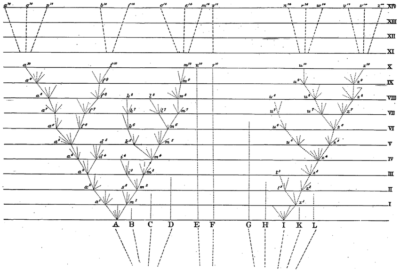 In the only diagram in The Origin of Species [pictured], Darwin illustrates the relationship between natural selection and long periods of time. Acquiring variations and passing them from one generation to the next is a time-consuming process. As Darwin explains –
In the only diagram in The Origin of Species [pictured], Darwin illustrates the relationship between natural selection and long periods of time. Acquiring variations and passing them from one generation to the next is a time-consuming process. As Darwin explains –
“As natural selection acts solely by accumulating slight, successive, favorable variations, it can produce no great or sudden modification; it can act only by very short and slow steps.”
However, as Lyell cautioned against, Darwin synchronizes geological timeframes with biological generations. In the description of The Origin of Species diagram, Darwin links the relationships between biological generations, geology, and time, noting –
“In the diagram, each horizontal line has hitherto been supposed to represent a thousand generations, but each may represent a million or hundred million generations, and likewise a section of the successive strata of the earth’s crust.”
Ironically, while inferring biological generations represents some timeframe of evolution, Darwin never quantified his concept. And the terms “interval” and “period” are used interchangeably. In the first edition, Darwin described these as –
“… each horizontal line has hitherto been supposed to represent a thousand generations, but each may represent a million or hundred million generations.”
Model Adjustment
By the sixth and final edition, Darwin mixed the sentence to –
“The intervals between the horizontal lines in the diagram, may represent each a thousand or more generations.”
Darwin vaguely infers the concept deep time to a number of generations to “get” an assumed number of species, writing –
“By continuing the same process for a greater number of generations (as shown in the diagram in a condensed and simplified manner), we get eight species, marked by the letters between a14 and m14, all descended from (A).”
Using inferences and metaphors, Darwin uses circular reasoning to infer how deep time makes natural selection plausible. Darwin inextricably tethered natural selection to deep time.
Long Periods of Time Logic
 In The Origin of Species, the terms “periods” (369), “lapsed time” (18), “periods of time“ (13), and “intervals of time” (27) appear a total of 427 times. Beyond these terms, Darwin used numerous biological constructs to justify deep time.
In The Origin of Species, the terms “periods” (369), “lapsed time” (18), “periods of time“ (13), and “intervals of time” (27) appear a total of 427 times. Beyond these terms, Darwin used numerous biological constructs to justify deep time.
In using his logical approach, for example, Darwin viewed deep time resolving the improbability of natural selection. Using the eye as an example, Darwin reasoned –
“To suppose that the eye… could have been formed by natural selection, seems, I freely confess, absurd in the highest degree… [But] let this process go on for millions of years… may we not believe that a living optical instrument might thus be formed?”
Viewing deep time differently, Darwin used it as a logical excuse for the perceived incompleteness of the fossil record. Darwin argued that the incompleteness stemmed from the vastness of time and the rarity of preservation, writing –
“Of this history we possess the last volume alone, of which only here and there a short chapter has been preserved; and of each page, only a few lines.”
For Darwin, deep time logically resolves the improbability of natural selection yet dissolves the probability of a complete fossil record. Philosophical-centric management.
However, Darwin’s reasoning ultimately led to circular dead ends.
Circular Reasoning
 Circular reasoning is a logical fallacy since the conclusion of an argument is assumed in the premise, even though the conclusions that may be either true or false. Alone, circular reasoning does not prove anything.
Circular reasoning is a logical fallacy since the conclusion of an argument is assumed in the premise, even though the conclusions that may be either true or false. Alone, circular reasoning does not prove anything.
For a conclusion to be scientifically valid, the reasoning must be founded on objectively definable independent evidence.
Factual or scientific conclusions based on premises without objective evidence are at risk of being a logical fallacy. Circular reasoning conclusions may only be restatements of the premise.
Circular reasoning remains pervasive throughout evolutionary literature, particularly in radiometric and molecular clock dating approaches, as will be discussed. However, using circular reasoning can give the illusion of a scientific argument.
Interestingly, the concept of linking long time periods to natural selection was initially introduced as a principle of evolution by an English economist.
Darwin, a Time-Model Critic
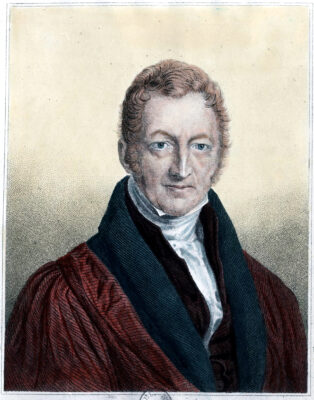 English economist Thomas Robert Malthus (pictured right) influenced Darwin’s theory of evolution on multiple levels, specifically concepts of growth and time. Darwin credits Malthus’s population growth concept for understanding how natural selection could work.
English economist Thomas Robert Malthus (pictured right) influenced Darwin’s theory of evolution on multiple levels, specifically concepts of growth and time. Darwin credits Malthus’s population growth concept for understanding how natural selection could work.
However, Darwin eventually became a critic of his own biological time-model, writing –
“New species have come on the stage slowly and at successive intervals; and the amount of change, after equal intervals of time, is widely different in different groups.”
Observations of “widely different” time intervals between “different groups” complicated how Malthus’s population concept might apply to natural selection.
However, even without a scientifically valid understanding of evolution timeframes, interest in Darwin’s theory had already launched a cultural revolution.
HMS Challenger Search
 In 1872, the British Parliament commissioned the HMS Challenger to search for Darwin’s missing evidence. After four years of work, however, Challenger’s global search for Darwin’s missing evidence ended.
In 1872, the British Parliament commissioned the HMS Challenger to search for Darwin’s missing evidence. After four years of work, however, Challenger’s global search for Darwin’s missing evidence ended.
At the time, marine life deep in the oceans was expected to demonstrate evidence of Darwin’s missing transitional links. However, the voyage proved to be a successful oceanographic mission; the search for evidence to support Darwin’s theory was a bust.
While a vast diversity of organisms was discovered in all depths, evidence of Darwin’s missing links remained beyond their reach. And notably, evidence to support Darwin’s “long periods of time” concept never materialized.
By the end of the nineteenth century, interest in Darwin’s theory had nearly vanished. However, an astonishing biological rediscovery at the turn of the century changed everything.
A few decades later, developments in nuclear technology opened new avenues to scientifically study the history of Earth’s biosphere. A new era had finally emerged, equipped for experimenting in the fields of geology and biology in support of Darwin’s theory.
Twenty-First Century Evolutionary Timeframes
 By the twentieth century, the geological concepts of Eons, Eras, Periods, Epochs, and Ages emerged as popular evolutionary timeframes. These were introduced earlier by Giovanni Arduino during the eighteenth century and subsequently developed into evolution’s de facto timeframes.
By the twentieth century, the geological concepts of Eons, Eras, Periods, Epochs, and Ages emerged as popular evolutionary timeframes. These were introduced earlier by Giovanni Arduino during the eighteenth century and subsequently developed into evolution’s de facto timeframes.
Modern illustrations of these timeframes (pictured right) are known as stratigraphic charts. Eons are the most extended periods, spanning hundreds of millions to billions of years from their beginnings. Ages, the shortest of periods, are inferred to span millions to tens of millions of years.
Stratigraphic geological studies form the foundation for developing the widely used chronostratigraphic charts. Chrono refers to time, and stratigraphy refers to the study of layered rocks (strata). Finding scientific evidence for Darwin’s “long periods of time” finally seemed probable.
Since then, multiple organizations have published different types of chronostratigraphic charts.
Geological Dating Challenges
 Charts published by the International Commission on Stratigraphy (ICS) are considered the most authoritative (picture charts). However, the elements used to construct all charts have known uncertainties.
Charts published by the International Commission on Stratigraphy (ICS) are considered the most authoritative (picture charts). However, the elements used to construct all charts have known uncertainties.
Currently, a consensus on managing uncertainties has yet to be developed. In acknowledging these uncertainties, ICS includes the following disclaimer on its charts –
“Numerical ages are subject to ongoing revision and do not define units…”
Modern evolutionary timeframes in chronostratigraphic charts depict layers of assumptions and inferences; in short, logical uncertainties.
Refer to Dating Earth’s Crust for more on the uncertainties of geological dating.
However, an evolutionary timeframe of Earth’s biosphere requires a composite synthesis of geological and biological evidence.
Earth’s Biosphere
 In 1875, Austrian geologist Eduard Suess (pictured left) introduced the term “biosphere” in his work, Die Entstehung der Alpen. Suess viewed Earth’s biosphere as the place on Earth’s surface where life dwells.
In 1875, Austrian geologist Eduard Suess (pictured left) introduced the term “biosphere” in his work, Die Entstehung der Alpen. Suess viewed Earth’s biosphere as the place on Earth’s surface where life dwells.
Earth’s biosphere is likened to a snapshot of a two-sided coin. One side is abiotic, inert forces, and the other side is biotic, reproductive intelligence machines. However, while the analogy is valid, since each side uses different types of data for measuring time, synchronizing conflicts are inevitable.
In geology, stratigraphic observations and radiometric dating provide the objective evidence to study time. However, erosion, non-deposition, and tectonic disruption fragment geological observations.
In biology, modern biotechnological advances have revolutionized access to objective evidence to examine the timing of past events. However, phylogenetic trees, molecular clocks, and pedigree-based mutation rates require assumptions.
While timeframes can be formulated with geological and biological data, their timeframe data differ greatly. Therefore, evolution scientists must use a systematic approach to synchronize these two different types of data sets.
To synchronize these diverse data sets, evolution scientists use epistemic reasoning. But this gets tricky.
Epistemic Reasoning
 The root term, epistemology, originates from the Greek ἐπιστήμη (episteme, meaning knowledge or understanding) and λόγος (logos, meaning study of). Essentially, epistemology can be used to synchronize acquired knowledge.
The root term, epistemology, originates from the Greek ἐπιστήμη (episteme, meaning knowledge or understanding) and λόγος (logos, meaning study of). Essentially, epistemology can be used to synchronize acquired knowledge.
A massive knowledge base of geological and biological data has been acquired over the past half-century. Epistemic logic is regularly used in evolutionary studies.
However, no scientific organization has developed a consensus on how to apply epistemic reasoning in evolution studies. Developing timeframes of evolution is the wild-west side of science. As a Yale geologist, Alec Brenner, recently noted in LiveScience –
“Unravelling Earth’s 4.5-billion-year history with rocks is tricky business.”
The issues challenging the development of evolution timeframes begin with the uncertainties in the data and the uncertainties in the reasoning process.
Refer to Reasoning Uncertainties for more on the uncertainties of radiometric and molecular dating.
In the late 1990s, TimeTree, a scientific evolution organization, was founded to compile published geological and biological data into a computer database.
TimeTree
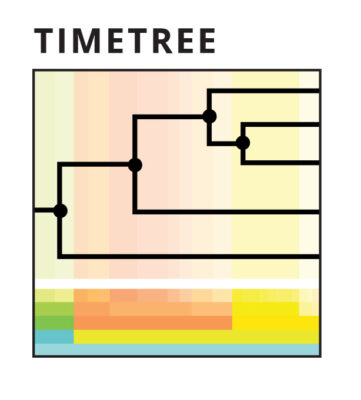 TimeTree (logo pictured left) offers the most comprehensive and publicly available tool to apply epistemic reasoning for exploring the history of Earth’s biosphere.
TimeTree (logo pictured left) offers the most comprehensive and publicly available tool to apply epistemic reasoning for exploring the history of Earth’s biosphere.
The National Science Foundation, NASA Astrobiology Institute, and the Science Foundation of Arizona support the TimeTree project. Currently hosted at Temple University, the database includes over 4,200 published molecular phylogenies covering more than 148,000 species.
 David Attenborough incorporated TreeTime’s timeframe graph (pictured) in his Rise of Animals: Triumph of the Vertebrates series. The BBC initially aired the documentary series in 2013. It is still currently available on Netflix, YouTube TV, Amazon Prime, and Apple TV.
David Attenborough incorporated TreeTime’s timeframe graph (pictured) in his Rise of Animals: Triumph of the Vertebrates series. The BBC initially aired the documentary series in 2013. It is still currently available on Netflix, YouTube TV, Amazon Prime, and Apple TV.
TimeTree is currently the de facto authoritative source for proposing the timeframes of evolution. However, a measure of the known uncertainties is currently not a practice with published timeframes.
The discovery of living fossils and soft tissue preservation in fossils continues to challenge even the most advanced timeframes of evolution.
Biological Timeframe Challenges
The term, living fossils, was coined by Darwin in The Origin of Species. Darwin called living fossils “quiet observers” – relics untouched by natural selection.
Living Fossils
 Species, once thought to be extinct, discovered contemporarily but seemingly unchanged from their fossilized forms, are known as living fossils. Darwin considered the Lungfish and the Platypus as examples.
Species, once thought to be extinct, discovered contemporarily but seemingly unchanged from their fossilized forms, are known as living fossils. Darwin considered the Lungfish and the Platypus as examples.
More recently, the Coelacanth, once thought extinct for millions of years, was discovered off the coast of South America in 1938. Horseshoe crabs and ginkgo trees are other popular living fossil examples.
Living fossils force a new reckoning over assumptions about tempo, mode, directionality, and the scientific validity of biological evolution.
Stabilizing selection is one popular logical explanation for living fossils. Some evolution scientists assume these are reflective of a new, yet undefined, type of evolutionary process. The concept of living fossils is highly debated among evolutionary scientists.
Soft-Tissue Preservations
 In a 2007 discovery, Mary Schweitzer (pictured left), an American paleontologist, revolutionized the scope of modern evolution studies. In a T Rex dinosaur fossil, thought to be millions of years old, Schweitzer reported finding evidence of flexible blood vessels and red blood cells.
In a 2007 discovery, Mary Schweitzer (pictured left), an American paleontologist, revolutionized the scope of modern evolution studies. In a T Rex dinosaur fossil, thought to be millions of years old, Schweitzer reported finding evidence of flexible blood vessels and red blood cells.
This level of preservation had long been understood to be impossible. Proteins and soft tissues degrade via hydrolysis and oxidation, even in cold, anoxic conditions. Preservation over millions of years defies known chemical kinetics.
But an increasing number of similar discoveries, once shocking, continue to upend basic assumptions about fossils. This level of preservation suggests either exceptional preservation or prompts a reevaluation of long-standing fossil age assumptions.
Methuselah
 Methuselah (Pinus longaeva) (pictured right), the Earth’s oldest tree, currently living in White Mountains, California, is credited as the Earth’s oldest tree. Based on tree-ring analysis (dendrochronology), Methuselah’s estimated age is 4,857 years.
Methuselah (Pinus longaeva) (pictured right), the Earth’s oldest tree, currently living in White Mountains, California, is credited as the Earth’s oldest tree. Based on tree-ring analysis (dendrochronology), Methuselah’s estimated age is 4,857 years.
The scientific validity of radiometric and molecular clock dating methods, with all its uncertainties, need to include the following disclaimer, too –
“Numerical ages are subject to ongoing revision…”
Genesis
 Time holds the scaffolding of every physical law in the universe. Yet, understanding the history of time seems to remain beyond the reach of science.
Time holds the scaffolding of every physical law in the universe. Yet, understanding the history of time seems to remain beyond the reach of science.
A “beginning” in the history of time is universally recognized time principle. While never challenging Moses’s “beginning” concept, the search for deep time remains a logical uncertainty.
Sir Isaac Newton (pictured left), an English physicist and mathematician, the most recognized scientist of the scientific revolution, Newton, declared –
“Truth is ever to be found in the simplicity, and not in the multiplicity and confusion of things.”
Whatever the timeframes of evolution might be, the probability of any of them being simple seems uncertain and increasingly improbable.
Time, Fourth Principle of Natural Selection is a Theory and Consensus article.
More
Natural selection’s five principles, abbreviated as V.I.S.T.A., include –
-
- Variation, First Evolution Principle
- Inheritance, Second Evolution Principle
- Selection, Third Principle of Evolution
- Time
- Adaptation, Fifth Principle of Natural Selection – under construction
Darwin Then and Now is an educational resource on the intersection of evolution and science, highlighting the ongoing challenges to the theory of evolution.
Move On
Explore how to understand twenty-first-century concepts of evolution further using the following links –
-
- The Understanding Evolution category showcases how varying historical study approaches to evolution have led to varying conclusions. Subcategories include –
- Studying Evolution explains how key evolution terms and concepts have changed since the 1958 publication of The Origin of Species.
- What is Science explains Charles Darwin’s approach to science and how modern science approaches can be applied for different investigative purposes.
- Evolution and Science feature study articles on how scientific evidence influences the current understanding of evolution.
- Theory and Consensus feature articles on the historical timelines of the theory and Natural Selection.
- The Biography of Charles Darwin category showcases relevant aspects of his life.
- The Glossary defines terms used in studying the theory of biological evolution.
- The Understanding Evolution category showcases how varying historical study approaches to evolution have led to varying conclusions. Subcategories include –

